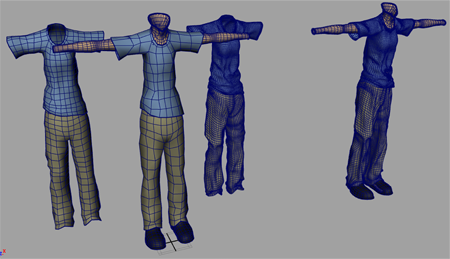Throughout this tutorial, you use four variations of the character’s polygon mesh clothing: a low resolution, medium resolution, high resolution, and reference character version. To view the tutorial assets, open Character_Multiple_Resolution.mb in Maya. The following sections describe each asset.
Use of any data from The Spine in this tutorial is courtesy of the National Film Board of Canada.

From left to right, the assets are, the medium resolution shirt and pants, low resolution shirt and pants, high resolution shirt and pants, and reference character.
The low resolution shirt (Shirt_LowRes) and pants (Pants_LowRes) objects are the low resolution meshes that you convert to nCloth and simulate. Most lessons in this tutorial focus on optimizing the simulation of these low resolution objects. The low resolution shirt and pants are used as the wrap influence objects for the wrap deformer. The Shirt_LowRes object consists of 180 faces and the Pants_LowRes object consists of 244 faces.
The high resolution shirt (Shirt_HighRes) and pants (Pants_HighRes) objects are the high resolution meshes used as the deform objects for the wrap deformer. At various stages of this tutorial, you show these meshes in the scene view to observe how the wrap deformer meshes behave when influenced by the low resolution nCloth shirt and pants. The Shirt_HighRes object consists of 6510 faces and the Pants_HighRes object consists of 5712 faces.
In the final lesson of the tutorial, you apply a custom nCloth attribute preset to the medium shirt (Shirt_MedRes) and pants (Pants_MedRes) objects. The nCloth preset is created from the attribute values used for the low resolution nCloth simulation. Like the low resolution shirt and pants, the medium resolution objects are also used as the wrap influence objects for the wrap deformer.
The reference character (Reference_Character) is a high resolution version of the character and clothing (shirt and pants), which is animated using a cached simulation. It represents the final high resolution mesh that you want to emulate when simulating the low resolution meshes with the wrap deformer. At various stages of the tutorial, you can display the reference character object in the scene view to compare with your current low resolution nCloth simulation.
In the tutorial scene files, the reference character appears hidden. To display the object, turn on Visible in the Display Layer editor.
For information about the Display Layer editor, see Display Layer editor in the Basics guide.
In this tutorial, the terms low, medium, and high resolution are used to distinguish each mesh. The terminology is not intended to define the composition of a low, medium, or high resolution mesh, but rather to describe the mesh’s general characteristics. When modeling geometry for nCloth, consider the following guidelines:
For example, if the nCloth is used for a character in the foreground of your scene you will want to use a high or medium resolution mesh. If the character is a stand-in or in the background of the scene, lower resolution meshes may be sufficient.
 Except where otherwise noted, this work is licensed under a Creative Commons Attribution-NonCommercial-ShareAlike 3.0 Unported License
Except where otherwise noted, this work is licensed under a Creative Commons Attribution-NonCommercial-ShareAlike 3.0 Unported License